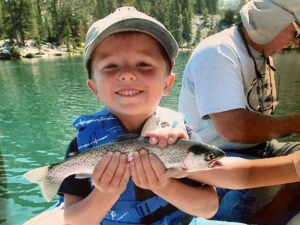From its headwaters in eastern Idaho and Wyoming, the upper tributaries of the Snake River boast some of the best fishing on the planet. The situation is much different downriver and across the state to the Oregon border. The once-mighty river dwindles to a trickle in places. Hot and full of pollution from agriculture and other industries, the river is plagued by algae outbreaks, killing fish and prompting warnings for humans and their pets to stay out of the water. The Snake River has defined much of the history in the region, and through “Stories of the Snake,” we bring to light the adventures and economic, historical, and cultural values this mighty river has provided for generations, and why stronger protections are needed to keep it this way.
Much of the east Idaho community’s identity has been developed through the love of fishing the river that flows right through their backyard. To better understand this relationship between people and place, I met with a passionate stream ecology student at Idaho State University to hear about his experiences and observations on the Snake River. Born and raised in Pocatello, Carson King spent much of his childhood, adolescence, and now early adult life exploring the abundant fishing opportunities on the Snake River.

At eight years old, Carson learned the art of fly fishing from his grandfather on the South Fork of the Snake River. The two would load up in his grandpa’s float boat and spend countless hours casting, mending, and catching. As most people do, Carson vividly remembers the first time he saw a fish take his fly on the water surface. “I had been fishing the night before with absolutely no luck, so we got up early, loaded up in the boat, and began a ten mile day on the Snake,” recalled Carson. “The day was a bust – we had no fish activity. As we were pulling up to the takeout, I threw out an extra big foam grasshopper on the bank. To my surprise, a big, native cutthroat launched up and took it. What a way to get into fly fishing – a native fish on an epic stretch of river.”
Catching that cutthroat was a life-changing moment for Carson. Since then, he has spent much of his spare time in, on, and along the Snake River. “When you throw a fly in the water, especially one you tied yourself, and a fish comes and eats it – it is one of the coolest and most rewarding experiences,” said Carson.

As Carson got older, he began exploring more water activities on the Snake. It was near Alpine, Wyoming where he learned to row and kayak. Carson’s experiences on this crystal clear, cold water made him fall in love with rowing and kayaking on fast-moving rivers. Now, he spends most of his summers kayaking, rowing, and exploring parts of the Snake. He also became a raft guide on Colorado’s Arkansas River. But even when his water hobbies learned on the Snake River take him across the West, the Snake always calls Carson back home. To honor the river he loves, Carson now looks for ways to give back to the Snake, which faces a slew of threats today.
In hot water
From overallocation to pollution, the Snake River as it flows through southern Idaho is in trouble. In some stretches of the Snake, the water is so polluted that it is now unsafe to recreate in and eat fish from. Decades of putting the industrial and agricultural uses of the river first have led to increased annual outbreaks of toxic algae, high levels of phosphorus in springs that flow into the mid-Snake, and increasing levels of nitrates in the Magic Valley’s groundwater. These changes aren’t going unnoticed.
“Here in Pocatello, the water is not running as it should,” said Carson. “Slow, flat water heats up fast, causing big problems. Go out on the river during the summer and you’ll see giant algae blooms. You’ll also see nonnative warm water species floating bloated at the top of the river – a big indicator that the water is not sustainable for trout.”

Optimal water temperature for trout is 44-67 degrees Fahrenheit, which is problematic for Idaho fish – especially as climate change continues to bring hotter, drier, and longer summers. Since the Snake River in Idaho is a working river, it is also often overallocated, meaning water levels are lowered for other use, raising water temperatures even further.
Overallocation, climate change, and pollution aren’t the only problems – human infrastructure inhibiting a free-flowing river also contributes to higher water temperatures. From the Snake’s headwaters to its confluence with the Columbia River, diminished water quality is impacting fisheries, the economy, and communities alike.
“From salmon to cutthroat trout – our native fish are dying,” said Carson. “When you see fish dying along an entire river, that’s a big deal. Native fish in a river system bring specific life-supporting nutrients into the river. Without these fish and the nutrients they bring, the river cannot be what it has been historically. The river is dying, and we should all be concerned.”
From Angler to Advocate

Carson’s firsthand experiences along the Snake have inspired him to study water quality and fisheries in college. He is also an active member of the Youth Salmon Protectors and is the Vice President of ISU’s American Fisheries Society chapter, which has allowed him to mobilize and educate community members about the ongoing water quality and fishery issues the Snake River is experiencing.
“From the crystal clear, fast-moving water near Alpine, Wyoming… to the wide, meandering river along the mid-Snake… and down near the four lower Snake River dams where the water moves excruciatingly slow – I have floated a lot of the Snake,” said Carson. “Being on a boat has given me a new perspective on how impacted the Snake is by humans. I have seen, firsthand, how the river should be versus how it actually is when it meets the Columbia.”
Carson isn’t alone in his quest to clean up the Snake River. ICL is working to restore the Snake River to a safe, swimmable, fishable condition. So many rely on the Snake River watershed’s water quality, and we must unite and work together to safeguard the river, hold polluters accountable, and promote efficient water use practices. Take action for the Snake River below by contacting Idaho’s elected officials, urging them to clean up the Mid-Snake.
As ICL navigates the future of water quality in the Snake River, it is pertinent to hear stories like Carson’s. No matter what your personal connection to the Snake is, there are so many reasons to stand up for it. Sign up here to learn more about the Snake River and how you can help restore it, and remember to take action below!
